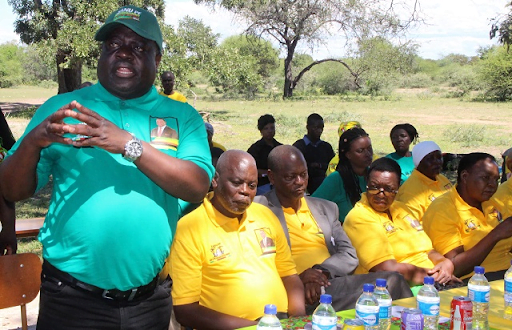Demystifying community entitlement of Mining proceeds in Zimbabwe

There is a general challenge in Zimbabwe regarding the relationship between some mining companies and communities in which they are situated.
By Edmond Mkaratigwa (MBA in Energy and Sustainability and Chairperson of the Parliamentary Portfolio Committee on Mines and Mining Development) & Albert Maipisi (Ph.D in Disaster Management).
The debate rages around whether mining companies are doing reasonably enough in their efforts of ploughing back part of exploited natural resource proceeds to communities in which they exist. The community has been defined as the area of operations cognisant that the society is catered for through tax obligations remitted and boosting the fiscus annually. Voices continue to rise from local communities and most thriving mining companies also have voluntary initiatives through which they give back to or support communities. Those initiatives are commonly known as Corporate Social Responsibility or Corporate Social Investment programmes whatever the nomenclature.
Advances in calls demanding for something more meaningful from mining companies are increasing. Non-governmental organisations, community-based organisations and particularly the more educated hailing from those communities are increasingly registering dissatisfaction. With the advent of the social media platforms and specifically in their Whatsapp groups and on group Facebook platforms, they are debating. Insightfully, some of these groups have more rights conscious participants in them domiciled in the country or foreign lands, with varied experiential exposures. Communities are getting more enlightened and to some extent are raising pertinent issues regarding the nature of their relationship with mining companies operating in their surroundings as well as expectations.
Other groups are still holed in support of the old dreaded Indigenisation and Empowerment Act utopia while others have a more liberal mind yet desiring to see an improvement from the prevailing. The major standpoints raised in support of the views converge on common concerns. Minds meet on the realisation that there are rampant environmental damages as a result of the nature of mining works. Especially through the cutting of trees, pollution of both air and natural water resource bodies, noise as well as shocks to property as a result of mine blasts. In the same vein, land used for mining is viewed as could have been used for other community livelihood options. Yes some have their own employed in the mines while others always demand their employment in-spite of their professional capacities. Further, social services infrastructure for health, water, and sanitation among others, have to some extend been improved or established through local existence and ‘providence’ of those corporates.
Access to more social services such as education has been improved to some, while the mass gathering as a result of the existence of mines has further created thriving and sustainable business hubs. In one group discussion, it was raised that there was a looming clash between a mine and the community. The clash emanated from the view that the mine has been buying vegetables from the nearby urban area for its canteens yet those were produced in abundance by local farmers in the rural community surrounding the mine. The observation raised tempers although some among the social group members were of the legal opinion that mining companies are private entities hence can buy from whichever market in the choice world. It is true but the social license of some of those companies is already being weakened whether the community will implement options that they agreed to consider for addressing that perceived anomaly or not.
In the same vein, the fact that mines are operating using heavy equipment and machinery with employees believed to be modestly rewarded and driving state of the art cars paints another image in the minds of poor communities surrounding the mines as well as their sympathisers who may be living outside that community permanently or temporarily. It is not easily understood by the ordinary person that mines as entities sometimes fail to have excess resources to plough back to those communities as social responsibility or investment. The same case was also witnessed where a mining company had a debt obligation it was servicing for around five years. The company has previously been an ardent corporate social responsibility or investment implementer. Due to business downs and turns, and the around five-year loan obligation for recapitalisation and expansion, it could not fulfill the expectation that was already planted and blossoming among the community members. That set the company on a sad plinth because all else on site is viewed as normal yet the books of accounts are silently speaking differently.
The dilemma around the immediate last case pierces the veil of current corporate social responsibility or investment approaches too. The approaches appear not durable and unsustainable, which restores the mind in some communities that the Indigenisation Act had its other bright than dim side alone. On the other hand, the case of vegetables which were procured from an urban market than locally raises the debate around which season was being referred to. Interrogation on seasonality goes back to the nature of rural community gardens which are usually seasonally productive. In that mind, whereas initiatives are in place and sometimes gardens established through corporate social responsibility or investment initiatives, the picture painted is that they are also not sustainable.
The two cases reveal weaknesses in the sustainability of the vehicle that funds the corporate social responsibility or investment initiatives as well as failure to establish sustainable livelihoods in the mining communities. Where corporate social responsibility and investment has been implemented more religiously, it has curbed appetite for governments and local communities to implement more radical demands on companies to implement more durable initiatives. The failure of these companies to implement such initiatives is sometimes perceivably attributed by communities, to corrupt or weak government leadership yet market economies should be freer as people get in business and choose investment destinations by their own choice. Nonetheless, it is not known what the growing consciousness of those communities means for the future of mining investment in Zimbabwe.
Questions often raised in those platforms further delves into the state of Community Share Ownership Schemes previously established in different mining communities in Zimbabwe. Ironically, the share ownership is all about equity participation, and yet there are no dividends hence the mystery being demystified. In many cases, it has not been clear whether these vehicles are still funded although some perceive the share certificates issued thereof were mere billboards. Questions arise again on what was happening to the prior funds invested in the schemes. Nevertheless, there are different views and perceptions postulated from different quarters although in the broader context accusations and mudslinging takes centre stage.
Dynamics on changes in mode and mechanisms for ploughing back to the communities have created that fog and friction but the core fact remains. It is the community demanding for what they perceive as their share from the corporates which have presumably accepted that demand by initiating those corporate social responsibility and investment initiatives. In South Africa and India where the community has been aggressive, violent, mobilised, and conscious, more market-based initiatives for securing mining companies’ social licenses have been advanced and implemented. Further, the fact that mining companies are implementing their initiatives at company level is also shifting to trusts that are more of investment vehicles which are remarkably sustainable and whose life span over many years post-mining. Where a group of mining companies establishes a trust, they have managed to invest their finances in line with their different company philanthropic philosophies and missions yet with a small high-tech administration team dedicated for that purpose.
Published ideas are entirely views of the two authors as academics and cannot be attributed to their positions.




